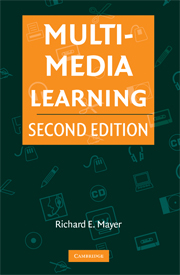Book contents
- Frontmatter
- Contents
- PREFACE
- SECTION I INTRODUCTION TO MULTIMEDIA LEARNING
- 1 The Promise of Multimedia Learning
- 2 The Science of Instruction: Determining What Works in Multimedia Learning
- 3 The Science of Learning: Determining How Multimedia Learning Works
- SECTION II PRINCIPLES FOR REDUCING EXTRANEOUS PROCESSING IN MULTIMEDIA LEARNING
- SECTION III Principles for Managing Essential Processing in Multimedia Learning
- SECTION IV PRINCIPLES FOR FOSTERING GENERATIVE PROCESSING IN MULTIMEDIA LEARNING
- SECTION V CONCLUSION
- REFERENCES
- AUTHOR INDEX
- SUBJECT INDEX
- References
3 - The Science of Learning: Determining How Multimedia Learning Works
- Frontmatter
- Contents
- PREFACE
- SECTION I INTRODUCTION TO MULTIMEDIA LEARNING
- 1 The Promise of Multimedia Learning
- 2 The Science of Instruction: Determining What Works in Multimedia Learning
- 3 The Science of Learning: Determining How Multimedia Learning Works
- SECTION II PRINCIPLES FOR REDUCING EXTRANEOUS PROCESSING IN MULTIMEDIA LEARNING
- SECTION III Principles for Managing Essential Processing in Multimedia Learning
- SECTION IV PRINCIPLES FOR FOSTERING GENERATIVE PROCESSING IN MULTIMEDIA LEARNING
- SECTION V CONCLUSION
- REFERENCES
- AUTHOR INDEX
- SUBJECT INDEX
- References
Summary
The science of learning is concerned with a theory of how people learn. Theory-grounded practice refers to developing instructional methods that are consistent with how people learn. Multimedia messages that are designed in light of how the human mind works are more likely to lead to meaningful learning than those that are not. A cognitive theory of multimedia learning assumes that the human information-processing system includes dual channels for visual/pictorial and auditory/verbal processing, each channel has limited capacity for processing, and active learning entails carrying out appropriate cognitive processing during learning. Five steps in multimedia learning are selecting relevant words from the presented text or narration, selecting relevant images from the presented illustrations, organizing the selected words into a coherent verbal representation, organizing selected images into a coherent visual representation, and integrating the visual and verbal representations and prior knowledge. Processing of pictures occurs mainly in the visual/pictorial channel; processing of spoken words occurs mainly in the auditory/verbal channel; but processing of printed words takes place initially in the visual/pictorial channel and then moves to the auditory/verbal channel. Three kinds of cognitive load are extraneous cognitive processing, which is cognitive processing that does not serve the instructional goal and is caused by poor instructional design; essential processing, which is cognitive processing that is required to represent the material in working memory and is determined by the complexity of the material; and generative processing, which is deep cognitive processing including organizing and integrating the material.
- Type
- Chapter
- Information
- Multimedia Learning , pp. 57 - 84Publisher: Cambridge University PressPrint publication year: 2009
References
- 4
- Cited by



